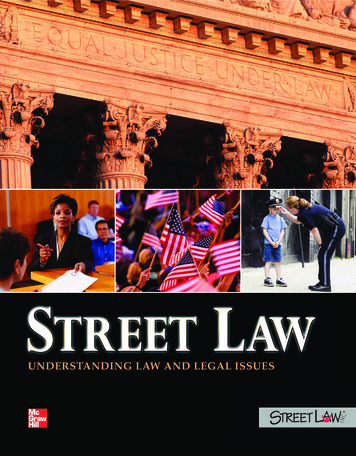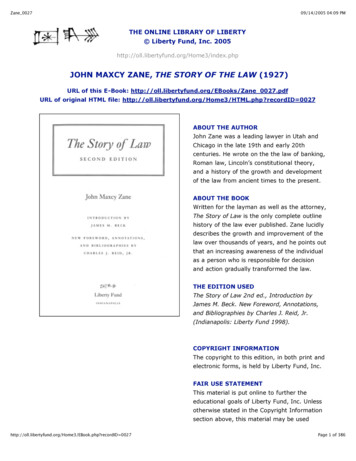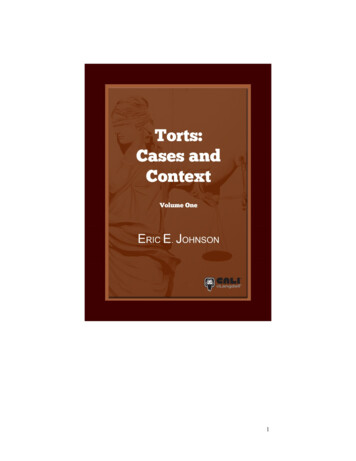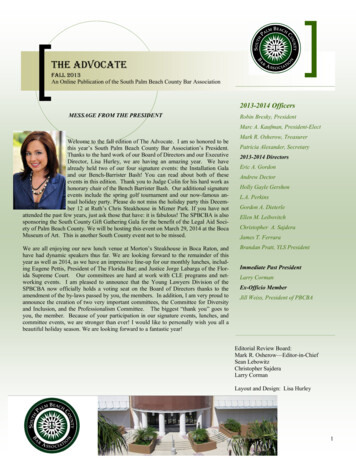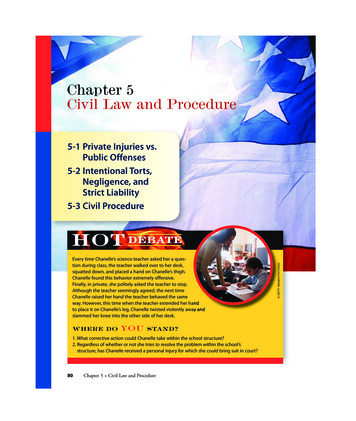
Transcription
Chapter 5Civil Law and ProcedureEvery time Chanelle’s science teacher asked her a question during class, the teacher walked over to her desk,squatted down, and placed a hand on Chanelle’s thigh.Chanelle found this behavior extremely offensive.Finally, in private, she politely asked the teacher to stop.Although the teacher seemingly agreed, the next timeChanelle raised her hand the teacher behaved the sameway. However, this time when the teacher extended her handto place it on Chanelle’s leg, Chanelle twisted violently away andslammed her knee into the other side of her desk.WHERE DOYOU STAND?1. What corrective action could Chanelle take within the school structure?2. Regardless of whether or not she tries to resolve the problem within the school’sstructure, has Chanelle received a personal injury for which she could bring suit in court?80Chapter 5 Civil Law and Procedure GETTY GETTYIMAGES/PHOTODISCIMAGES/PHOTODISC5-1 Private Injuries vs.Public Offenses5-2 Intentional Torts,Negligence, andStrict Liability5-3 Civil Procedure
5-1 Private Injuries vs. Public OffensesGOALSKEY TERMS Distinguish a crime from a torttortdamages Identify the elements of tortsnegligence Explain why one person may be responsiblefor another’s tortHow Do Crimes andTorts Differ?When he applied for hislicense as a ferry pilot for thecity, Jerone failed to tell theCoast Guard about his high blood pressureand prescription drug use. Some three yearslater, while operating the ferry, Jerone passedout at the controls. As a consequence, the ferrycrashed into the dock killing 18 commutersand injuring dozens more. At the time Jeronewas also taking two medications for back pain.Both the pain medications list drowsiness as apossible side effect.What'sYourVerdict?One act can be both a tort and a crime. InWhat’s Your Verdict? Jerone committed twocrimes—the crime of manslaughter (18 counts)and the crime of failing to disclose his drug useand blood pressure status in applying for theposition.Jerone also committed a tort by his negligentconduct in piloting the ferry. Manslaughter ispunishable in most states by up to 10 years inprison for each count. Damages for negligencewill be awarded appropriate to the claims ofthe injured and the families and estates of thedeceased passengers.CHECKPOINt What is the differencebetween a crime and a tort?A crime is an offense againstsociety. It is a public wrong.A tort, in contrast, is a private or civil wrong. It is anoffense against an individual.If someone commits a tort, theperson injured as a result cansue and obtain a judgment fordamages. This is a monetaryaward intended to compensatethe injured party for theharm done to her or him.From society’s standpoint, themoney is meant to restrainthe injured individual’s desireto exact revenge by taking thelaw into her or his own hands.Doing so would cause chaos. GETTY IMAGES/PHOTODISCDoes Jerone’s conduct represent acriminal or civil wrong or both?What is the purpose of an injured party’s receiving money damages for a tortcommitted against him or her?5-1 Private Injuries vs. Public Offenses81
Elements of a TortOn a windy autumn day,Mason was burning dryleaves in his backyard. Whenhe went inside to answer a telephone call,flames from the fire leaped to the next-doorneighbor’s fence and then to a tool shedwhere a small can of gasoline exploded.Soon the neighbor’s house was ablaze, and itburned to the ground.What'sYourVerdict?Did Mason commit a tort?Like criminal law, tort law is a broad legal category. Just as there are many specific crimes, therealso are many specific torts. Certain elementsare common to most torts. In a trial, these elements must be proved to establish liability (legalresponsibility).The elements of most torts include1. duty (a legal obligation to do or not to dosomething)2. breach (a violation of the duty)3. injury (a harm that is recognized by the law)4. causation (proof that the breach caused theinjury)a question of law for the judge to decide. Ajudge will make this decision by consultingstate case and statutory law and, on occasion,federal law.VIOLATION OF THE DUTY A violation (or breach)of the duty must be proved before the injuredparty can collect damages. Whether a breach ofa tort duty has occurred is almost always a question of fact for a jury or a judge, if no jury isrequested, to decide.Many torts acknowledge a breach only whenthe defendant actually intended to inflict harmby her or his action. These are classified as intentional torts. In other torts, the intent to inflictharm is not required. It is enough that the harmoccurred as a result of the neglect or carelessnessof the defendant. Such a tort is generally termednegligence.In still other torts, even carelessness is notrequired. Liability is imposed simply because aperson acted in a certain way, and this causedinjury. The last classification, where neitherintent nor carelessness is required, is classified asstrict liability.INJURY Generally, injury resulting from thebreach of duty must be proved. Thus, if you actrecklessly, but no one is injured, there usually isno tort.DUTY By law, you have certain1. the duty not to injureanother (including bodilyinjury, injury to someone’sreputation, or invasion ofsomeone’s privacy)2. the duty not to interferewith the property rightsof others, for example, bytrespassing on their land3. the duty not to interferewith the economic rightsof others, such as the rightto contractWhether or not a dutyexists in a certain situation is82 GETTY IMAGES/PHOTODISCrights. You also have certainduties related to respecting therights of others. The followingare the duties created by tort law:Apply the elements of a tort to determine whether Mason in What’s YourVerdict? committed a tort in allowing the fire to occur. Check your answeragainst the explanation on the next page.Chapter 5 Civil Law and Procedure
CAUSATION Causation means that breach ofthe duty caused the injury. There are degrees ofcausation. For example, one could argue thatthe first people on earth are the ultimate causeof every injury that occurs in the world today.However, when the amount of causation is greatenough for it to be recognized by the law, it iscalled proximate cause. Generally, proximate causeexists when it is reasonably foreseeable that abreach of duty will result in an injury.Applying these elements to What’s Your Verdict?Mason committed a tort because (1) he owed aduty to the neighbors not to injure their property; (2) he breached the duty when he left thefire unattended so it spread to the neighbor’sproperty; (3) the injury occurred when theneighbor’s house was burned; and (4) leavingthe fire unattended was a proximate cause of theloss of the fence, the tool shed, and the house.Therefore, the neighbor can obtain a judgmentagainst Mason for the value of the loss.CHECKPOINt Name the four elements ofa tort.Responsibility forAnother’s TortsHunt was taking riding lessons from Saddleback Stables.Patterson, the Saddlebackinstructor, was a skilled rider although only15 years old. Nevertheless, during a lessonwhile leading the horse Hunt was riding,Patterson negligently dropped the bridle. As aresult, the horse bolted and Hunt was thrownto the ground and injured.What'sYourVerdict?Who was liable for Hunt’s injuries?With few exceptions, all persons, includingminors, are personally responsible for their conduct and are therefore liable for their torts. Evenchildren or insane persons may be held liable forinjuring others. Certainly, in What’s Your Verdict?Patterson’s negligence would result in his beingliable to Hunt for Hunt’s injuries. In addition,Saddleback Stables can be held liable for thenegligence of its employee Patterson. In suchcases, the injured party may sue both employerand employee.When one person is liable for the torts ofanother, the liability is called vicarious liability.For example, parents may be liable if they givetheir children “dangerous instrumentalities,” suchas guns, without proper instruction. Similarly,parents may be liable for their children’s continuing dangerous habits. For example, if a childcontinues to throw rocks at trains and vehicles,the parents may be liable if they fail to stop thechild’s behavior.In some states parents are liable, by statute,up to a specified amount of money for propertydamage by their minor children. This is usually designed to cover vandalism and maliciousdestruction of school property. Most states alsoprovide that parents are liable, up to the limitsof financial responsibility laws, for damages negligently caused by their children while operatingmotor vehicles.CHECKPOINt What parties might be heldresponsible for another person’s tort?Bottomless Barges, Inc. (BBI),contracted with a coastal cityto barge the city’s untreatedsewerage some 300 miles into the ocean anddump it. This activity was permitted by thefederal government due to the city’s lack offunds needed to build an adequate treatment facility. Ollee Facktory, an employee ofBBI, dumped an afternoon run only 35 milesoffshore in order to get back to land in timefor a date. Various diseases, including minorcases of cholera, broke out in several coastaltowns. As a result, BBI was sued by individualplaintiffs and the government and recovered against due to its vicarious liability forFacktory’s actions.In THISCASE5-1 Private Injuries vs. Public Offenses83
5-1 Assessmentschool.cengage.com/blaw/lawxtraTHINK ABOUT LEGAL CONCEPTS1. A single act can be both a tort and a crime. Trueor False?2. The degree of causation of a tort great enoughto be recognized by law is called(a) proximate cause (b) intimate cause (c) incidental cause (d) none of the above3. A tort is considered to be an offense againstsociety. True or False?4. In order to establish liability for a tort, all of thefollowing must be proved except (a) duty(b) breach of duty (c) harm recognized by law(d) vicarious liability5. An insane person cannot be held liable for atort. True or False?6. When one party is held responsible for the tortof another, the liability is called ? liability.7. The three classifications of torts are intentionaltorts, negligence, and ? . (a) manslaughter(b) strict liability (c) vicarious liability (d) none ofthe aboveTHINK CRITICALLY ABOUT EVIDENCEStudy the situation, answer the questions, and then prepare arguments to support your answers.8. Philip drove a tractor-trailer rig onto a ferry boat.He left the rig in gear because of a problem withits brakes. Posted regulations prohibited thestarting of engines before docking, but whenthe ferry was about 50 feet from the dock, Philipstarted his engine. That caused the tractortrailer to jump forward and strike Herrick’s car,which in turn hit Patton’s car. Patton’s car, at thehead of the line, crashed through the ferry’sbarricades and plunged into the water. The carcould not be recovered. What was the tort dutyin this case? Where was the breach of the duty?What were the injuries? What was the proximatecause of the injury to Patton’s car?9. Felicia carelessly left a campfire before it wascompletely extinguished. The fire spreadthrough the woods and caused the destructionof a nearby lodge. Is Felicia liable to the owners of the lodge for the building? Is she liableto the lodge owners for the loss of income untilthe lodge can be restored? Is she liable to thepersons who had reservations for the lodge butwhose trips are now ruined?10. The driver of a rental car lost control while passing another vehicle. The car crossed the medianof the four-lane highway and slammed head-oninto Todd’s truck. The truck then flipped overand caught fire. Todd suffered extensive burnsand his son, who had been riding with him, suffered traumatic brain injuries. The dollar value84Chapter 5 Civil Law and Procedureset on their injuries was more than 4 million.Against whom can they recover?11. As a police officer, Maureen was authorized tocarry her handgun with her. While darting intoa store to pick up her dry cleaning, she left thegun in her car hidden under the seat. Her 9-yearold son found the pistol and accidently shot hisfriend in the leg. Is Maureen liable for the injury?12. Patrick borrowed his friend John’s car toimpress a young lady he was dating. It was anew luxury car that John had saved four yearsto purchase. The paint on the car turned colorsunder various climatic and light conditions.While on the date, Patrick drove the car down apublic road that had just been repaved with hotoil and gravel. The result was streaks of hot oilglued to the sides of the car and several nicks inthe paint from flying rocks. Patrick then parkedin front of his favorite restaurant, a sports pubon the far side of town. While in the restaurant,Patrick heard a special weather report that athunderstorm with large hail was sweepingacross the area and would arrive over the restaurant in ten minutes. Unfortunately for John’scar, the date was going too well to break offand move the car under cover. Consequently,the hail left a multitude of pock marks on thetop of the car. Is Patrick legally responsible forthe damage done by the gravel, oil, and hail?Why or why not?
5-2 Intentional Torts, Negligence, and Strict LiabilityGOALSKEY TERMS Identify common intentional tortsintentional tortsassaultbatteryfalse imprisonmentdefamation Recognize the elements of negligence Explain the basis for strict liabilityWhat Are the MostCommon IntentionalTorts?During deer-hunting season,Hart drove miles into thecountry in search of game.He parked his pickup truck along a dirt road,climbed a fence, and hiked into the woods.Hart thought the land was part of a nationalforest. However, it actually belonged toQuincy, who had posted “No Trespassing”signs. Confronted by Quincy, Hart apologizedfor his mistake and left.Had Hart committed an intentional tort?“reasonable” from the viewpoint of the potentialvictim, the threat must be believable. The threatened injury can be physical: a person may raise afist threatening to punch you. Or the threatenedinjury can be offensive: a person might threatenunwanted sexual touching by attempting tokiss you.BatteryIntentional torts are torts in which the defend-ant possessed the intent or purpose to inflict theresultant injury. These torts contrast with negligence and strict liability, where intent to producethe injury is not required. There are numerousintentional torts. The most common of theseinclude assault, battery, false imprisonment,defamation, invasion of privacy, trespass to land,conversion, and fraud.The tort of assault occurs when one personintentionally puts another in reasonable fearof an offensive or harmful bodily contact. Anassault can be based on words or gestures.However conveyed, the threat must includea display of force indicating a present abilityto carry it out. In addition, to be consideredSpencer, elderly and totally blind,thought Wills had swindled him.Spencer told Wills that he wasgoing to “beat your face to a pulp.” Because itwas obvious that Spencer could not carry outhis threat, there was no assault.In THISCASEWhat'sYourVerdict?Assaultinvasion of privacytrespass to landconversionfraudstrict liabilityA person has a duty to refrain from harmful oroffensive touching of another. An intentional breachof the duty is a battery. Shooting, pushing in anger,spitting on, or throwing a pie in another’s face areall batteries. An assault frequently precedes a battery.Angrily raising a clenched fist and then striking someone in the face involves first an assault(the raised fist) and then a battery (the blow tothe face). When the victim is hit without warningfrom behind, there is a battery without an assault.Even though there is harmful or offensivetouching, there may be no battery if the contactis not intentional. This could occur, for example,when someone sneezes and their spittle inadvertently strikes another. Also, the contact may be justified. For example, when you act in self-defense,you have not committed a battery. Further, theremay be consent to the contact. Thus, in a boxing match, there is no battery because the boxersconsent to the harmful touching.5-2 Intentional Torts, Negligence, and Strict Liability85
GETTY IMAGES/PHOTODISCWhen the police have probable cause to arrest people, they areprivileged to imprison them. Privilegejustifies the imprisonment. But if thepolice mistake the identity of oneperson for another, they may commitfalse imprisonment in the course ofthe arrest. Merchants in many stateshave a privilege to detain a personif they have a reasonable basis forbelieving the person was shoplifting.If they detain persons against theirwill without a reasonable basis, theyfalsely imprison them.DefamationIs the action in this photo an example of assault or battery? Justify youranswer.False ImprisonmentFalse imprisonment is the intentional confinementof a person against the person’s will and withoutlawful privilege. People may be deprived of freedom of movement in many ways. For example,they may be handcuffed; locked in a room, car,or jail; told in a threatening way to stay in oneplace; or otherwise denied their liberty. Consentoccurs when they agree to being confined. Forexample, when a burglary suspect sits voluntarilyin a police car to describe his actions over the lasthour, the suspect consents to being detained.Defamatory statements published onInternet bulletin boards, e-mails, and thelike, are considered libel due to the somewhat permanent nature of the medium. Thisoften is vital to a successful suit for defamation as damages are presumed to exist in thecase of libel and do not have to be proven tothe court. The remaining question becomeswho should be sued. This is the hard part.Sections of the Communications DecencyAct of 1996 and several court decisions provide protections to Internet service providersand bulletin board operators. Such parties86Chapter 5 Civil Law and ProcedureStatements about people can injurethem. If a false statement injures aperson’s reputation or good name, itmay constitute the tort of defamation. If the defamation is spoken, it is slander. If the defamation iswritten or printed, it is libel. To be legally defamatory, the statement must1. be false (truth is a complete defense)2. be communicated to a third person (yourreputation is not harmed if no other personhears or reads the lie)3. bring the victim into disrepute, contempt, orridicule by othersIn slander suits, you must show that you havesuffered an actual physical loss, or damages, as agenerally are considered to be immune fromsuits brought to make up for the harm done bysuch statements. However, they may be heldliable if it can be shown that they exercisededitorial or full control of the material posted ortransmitted or, at least, had knowledge of thespecific defamatory contents. Such a showinghas proven very difficult to accomplish.THINK ABOUT ITWhy do you think it has been so difficult forpeople to win libel suits against Internet bulletinboard operators or Internet service providers?
result of the slanderous remark. Exceptions to thisoccur in cases where the oral statements are to theeffect that the plaintiff committed a serious crime,has a loathsome disease, or injures someone in hisor her profession or business. In libel cases, youare presumed to have suffered a loss, and so thesedamages do not have to be shown to the court.Exceptions are made to the law of defamationin order to encourage open discussion of issuesof public concern. For example, legislators’ statements, even those made with malice, are immunefrom liability if made during legislative meetings.Judges, lawyers, jurors, witnesses, and other parties in judicial proceedings are also immune fromInvasion of PrivacyPeople are entitled to keep personal matters private.This is the right to privacy. Congress has stated that“the right of privacy is a personal and fundamentalright protected by the Constitution of the UnitedStates.” Invasion of privacy is a tort defined as theuninvited intrusion into an individual’s personalrelationships and activities in a way likely to causeshame or mental suffering in an ordinary person.An invasion of privacy also can result fromunnecessary publicity regarding personal matters.So, unlike the law regarding the tort of defamation, publication of even a true statement aboutsomeone may be an invasion of privacy. This isbecause, as the U.S. Supreme Court put it, youshould be protected when you have a reasonable“expectation of privacy.” Thus, two-way mirrors BLEND IMAGESAgnozzi, who is deaf, purchased severalitems at a large chain discount store.One of the items was a large inflated dollfor his daughter. Agnozzi went to a cashregister near a store entrance to pay for hisgoods. The doll was so large that the salesclerk could not find a bag to hold it. Withthe doll under his arm and his other purchases in bags held in both hands, Agnozzileft the store. As he did so, a store employeestationed at the door to welcome peoplein and conduct security screens of thoseleaving, noticed the unbagged doll. Theemployee was instructed to stop and checkthe receipt of any party leaving the storewith an unbagged item. As a consequence,she asked Agnozzi to stop. When he didnot, she shouted at him to stop. Finally, sheyelled, “Stop thief, ” and gave chase. Otherstore personnel joined in and threw Agnozzidown onto the asphalt in the parking lot.Agnozzi finally was able to make the storepersonnel understand he was deaf and thathe had the receipt in his pocket. Upon seeing the receipt they let him go with apologies. Although he was embarrassed, hisclothes torn, and his skin scraped, Agnozziaccepted the apologies and left. Now heis reconsidering. Would it be ethical forAgnozzi to bring suit against the discountstore? Does Agnozzi owe a duty to bringsuit? If so, to whom and for what?liability for statements made during the actualtrial or hearing. Similarly, liability for defamatorystatements about public officials or prominentpersonalities does not exist unless the statementswere made with malice. That means the statementwhen issued was known to be false or was madewith a reckless disregard for its probable falsehood.What are some situations related to the right toprivacy that affect your life?5-2 Intentional Torts, Negligence, and Strict Liability87
Trespass to Land GETTY IMAGES/PHOTODISCin the women’s restroom of agas station would constitutean invasion of privacy.The right to privacy alsoincludes freedom from commercial exploitation of one’sname, picture, or endorsement without permission. Theright to privacy bans illegaleavesdropping by any listening device, interference withtelephone calls, and unauthorized opening of letters and telegrams. However, the right ofprivacy is not unlimited. Forexample, the police are permitted to tap telephone linessecretly if they have a warrantto do so. Also, public figures,such as politicians, actors, andpeople in the news, give upmuch of their right to privacywhen they step into the public domain.In order for the tort of trespass to occur, what would have to be proven about theperson who enters this property without the owner’s permission?The tort of trespass to landis entry onto the property of another without theowner’s consent. However, trespass may consist ofother forms of interference with the possession ofproperty. Dumping rubbish on the land of anotheror breaking the windows of a neighbor’s house alsoare trespasses. Intent is required to commit thetort of trespass. However, the only requirement isthat the intruder intended to be on the particularproperty. If a person were thrown onto another’sland, there would be no intent and no trespass. If aperson thought she was walking on her own property, but was mistaken, there would be a trespassbecause she intended to be there. Thus, in What’sYour Verdict? Hart was guilty of trespass, eventhough he thought he was in a national forest.innocent buyer of stolen goods is a converter. Theparty injured by the conversion can receive damages. Or the converter can, in effect, be compelledto purchase the converted goods from their owner.Interference withContractual RelationsGenerally parties who breach a contract to whichthey are a party must pay damages under contractlaw for the injury suffered by the other party.However if a third party encourages the breachingparty in any way, that third party may be liable intort to the non-breaching party. This is called thetort of interference with contractual relations.ConversionFraudPeople who own personal property, such as diamond rings, have the right to control their possession and their use. This right is violated if theproperty is stolen, destroyed, or used in a mannerinconsistent with the owner’s rights. If that happens,a conversion occurs. A thief is always a converter.Conversion occurs even when the converterdoes not know that there is a conversion. So, theFraud occurs when there is an intentional or reck-88Chapter 5 Civil Law and Procedurelessly made misrepresentation of an existing important fact. The misrepresentation must be made withthe intent of inducing someone to enter into a contract. Finally, the other party, relying on the misrepresentation, must actually enter into the contract.To be able to recover damages in court forfraud, the person alleging it must not have been
able to check on the truth of the statement byexercising due diligence. In addition, ordinarilya statement of opinion is not considered fraudulent. This is because the hearer should recognizethat the statement is the speaker’s personal view.Negligence is the most common tort. Intent toinjure is not required for this tort. Only carelessbehavior is required for negligence. Negligenceis proven in court by the showing of a duty ofdue care owed by the defendant to the plaintiff, abreach of that duty, causation, and injury.CHECKPOINt Name at least six of theDuty Imposed by Negligencemost common intentional torts.What ConstitutesNegligence?What'sYourVerdict?Britt was driving home lateone rainy night after drinking alcohol all evening. Withonly one working headlight, she raced downresidential streets at speeds up to 60 milesper hour. Meanwhile, Yee was slowly backingher station wagon out of her driveway, butshe failed to look both ways when she shouldhave. Britt rammed into the right rear end ofYee’s car. Both Yee and Britt were injured in thecollision and their vehicles severely damaged. GETTY IMAGES/PHOTODISCWho will have to pay damages for theinjuries and property damage sustainedin the accident?The general duty imposed by negligence law isdefined by the reasonable-person standard. Thisstandard requires that you act with the care, prudence, and good judgment of a reasonable personso as not to cause injury to others. In court, thetrier of fact (typically a jury) is asked how thereasonable person would have behaved underthe circumstances. The answer to this questionsets the standard of due care against which thedefendant’s actions will be compared.For certain individuals, a different degree ofcare is applied. For example, children under ageseven are held to be incapable of negligent conduct. Children seven through fourteen are onlyrequired to act with the care that a reasonablechild of like age, intelligence, and experiencewould act. If, however, a child undertakes anadult activity, such as driving a boat or a car, thechild is held to the adult standard.Professionals and skilled tradespersons are heldto a higher degree of care in their work. Thesepersons are required to work with the degreeIf the driver of this aquacycle is ten years old, would she be negligent if she ran into a swimmer? Why or why not?5-2 Intentional Torts, Negligence, and Strict Liability89
of care and skill that is normally possessed bymembers of the profession or trade. Thus, anattorney must act with the care and skill normally possessed by other attorneys in his or hercommunity. Similarly, a plumber must performwork with the care and skill normally exercisedby other plumbers in the community.vehicle while impaired was a breach of the duty,and it is reasonably foreseeable that speeding willcause injury. In fact, speeding was a partial causeof the property damage to the station wagon andthe personal injury to Yee.Breach of DutyIn several states a plaintiff cannot recover for losscaused by another’s negligence if the plaintiffalso was negligent. This is the old common lawdefense of contributory negligence. For example,in What’s Your Verdict? Yee was also negligentbecause she backed into the street without looking left or right. That and Britt’s speeding werecauses of the accident. So Yee was contributorilynegligent. If she lived in a state that allows contributory negligence as a defense, she could notrecover anything from Britt. Under this legalrule, it does not matter that one party, like Britt,was very negligent and primarily responsible forcausing the collision while the other, like Yee,was only slightly negligent.Most states have substituted comparative negligence for contributory negligence. Comparativenegligence applies when a plaintiff in a negligence action is partially at fault. In such acase the plaintiff and defendant are awardeddamages in proportion to their percentage ofThe “reasonable-person” standard defines theduty of due care in any specific case. A defendant’s actual conduct, such as Britt’s in What’sYour Verdict? is then compared with this specificduty to determine whether a violation of it hasoccurred. You could conclude that a reasonableperson would drive a car only at a safe speed,only when sober, and at night only when thecar’s lights work. Because Britt engaged in speeding, driving while intoxicated, and driving atnight without proper lights, she clearly breachedthe duty of due care set by the reasonable-personstandard.Causation and Injury GETTY IMAGES/PHOTODISCAs with other torts, the violation of the dutymust be the proximate cause of the injury. InWhat’s Your Verdict? Britt’s speeding
Like criminal law, tort law is a broad legal cate-gory. Just as there are many specific crimes, there also are many specific torts. Certain elements are common to most torts. In a trial, these ele-ments must be proved to establish liability (legal responsibility). The elements of most tor






